fuel cap TOYOTA COROLLA 2022 Owners Manual (in English)
[x] Cancel search | Manufacturer: TOYOTA, Model Year: 2022, Model line: COROLLA, Model: TOYOTA COROLLA 2022Pages: 678, PDF Size: 147.24 MB
Page 5 of 678
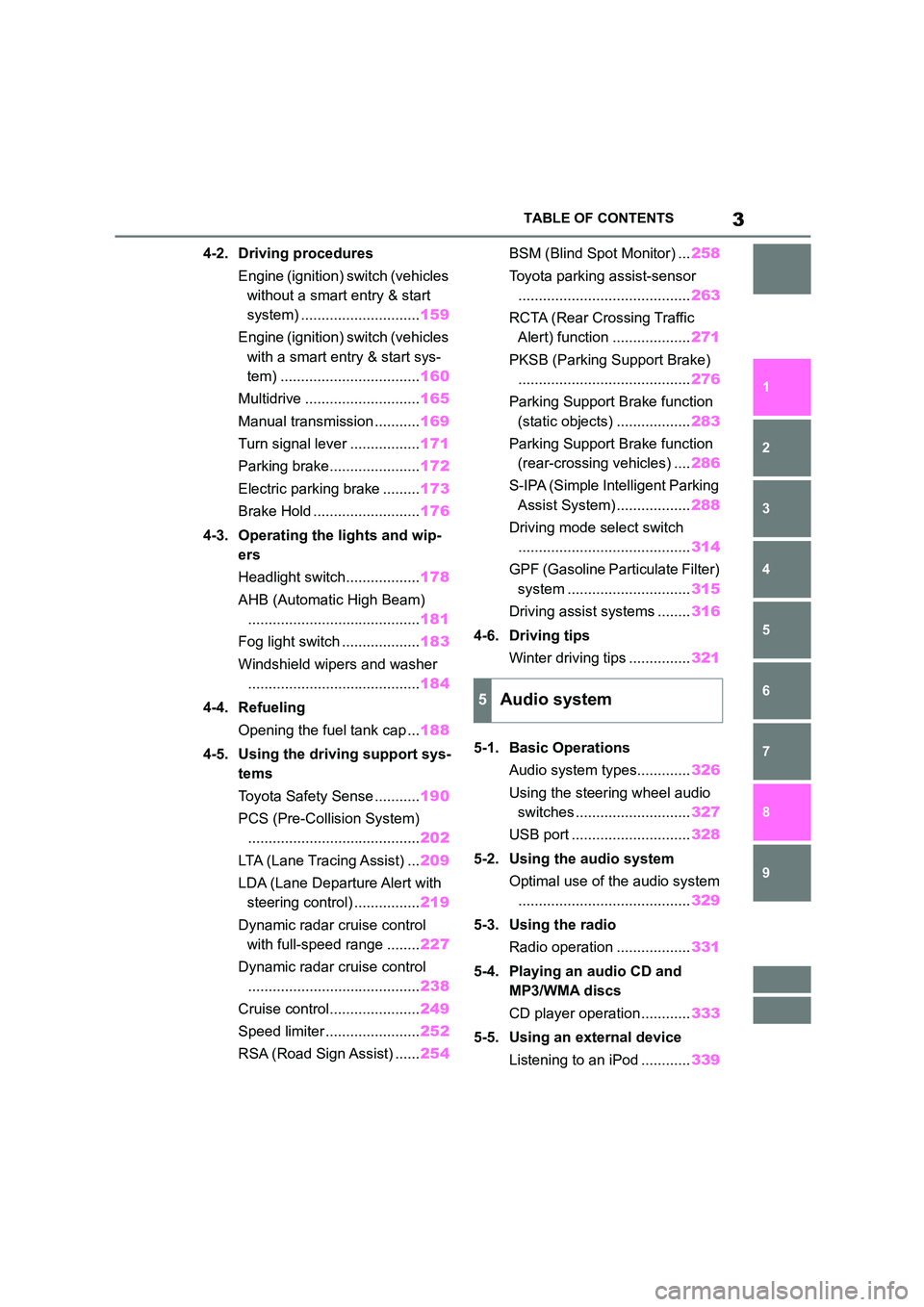
3TABLE OF CONTENTS
1
6
5
4
3
2
9
8
7
4-2. Driving procedures
Engine (ignition) switch (vehicles
without a smart entry & start
system) ............................. 159
Engine (ignition) switch (vehicles
with a smart entry & start sys-
tem) .................................. 160
Multidrive ............................ 165
Manual transmission ........... 169
Turn signal lever ................. 171
Parking brake...................... 172
Electric parking brake ......... 173
Brake Hold .......................... 176
4-3. Operating the lights and wip-
ers
Headlight switch.................. 178
AHB (Automatic High Beam)
.......................................... 181
Fog light switch ................... 183
Windshield wipers and washer
.......................................... 184
4-4. Refueling
Opening the fuel tank cap ... 188
4-5. Using the driving support sys-
tems
Toyota Safety Sense ........... 190
PCS (Pre-Collision System)
.......................................... 202
LTA (Lane Tracing Assist) ... 209
LDA (Lane Departure Alert with
steering control) ................ 219
Dynamic radar cruise control
with full-speed range ........ 227
Dynamic radar cruise control
.......................................... 238
Cruise control...................... 249
Speed limiter ....................... 252
RSA (Road Sign Assist) ...... 254
BSM (Blind Spot Monitor) ... 258
Toyota parking assist-sensor
.......................................... 263
RCTA (Rear Crossing Traffic
Alert) function ................... 271
PKSB (Parking Support Brake)
.......................................... 276
Parking Support Brake function
(static objects) .................. 283
Parking Support Brake function
(rear-crossing vehicles) .... 286
S-IPA (Simple Intelligent Parking
Assist System) .................. 288
Driving mode select switch
.......................................... 314
GPF (Gasoline Particulate Filter)
system .............................. 315
Driving assist systems ........ 316
4-6. Driving tips
Winter driving tips ............... 321
5-1. Basic Operations
Audio system types............. 326
Using the steering wheel audio
switches ............................ 327
USB port ............................. 328
5-2. Using the audio system
Optimal use of the audio system
.......................................... 329
5-3. Using the radio
Radio operation .................. 331
5-4. Playing an audio CD and
MP3/WMA discs
CD player operation ............ 333
5-5. Using an external device
Listening to an iPod ............ 339
5Audio system
Page 14 of 678
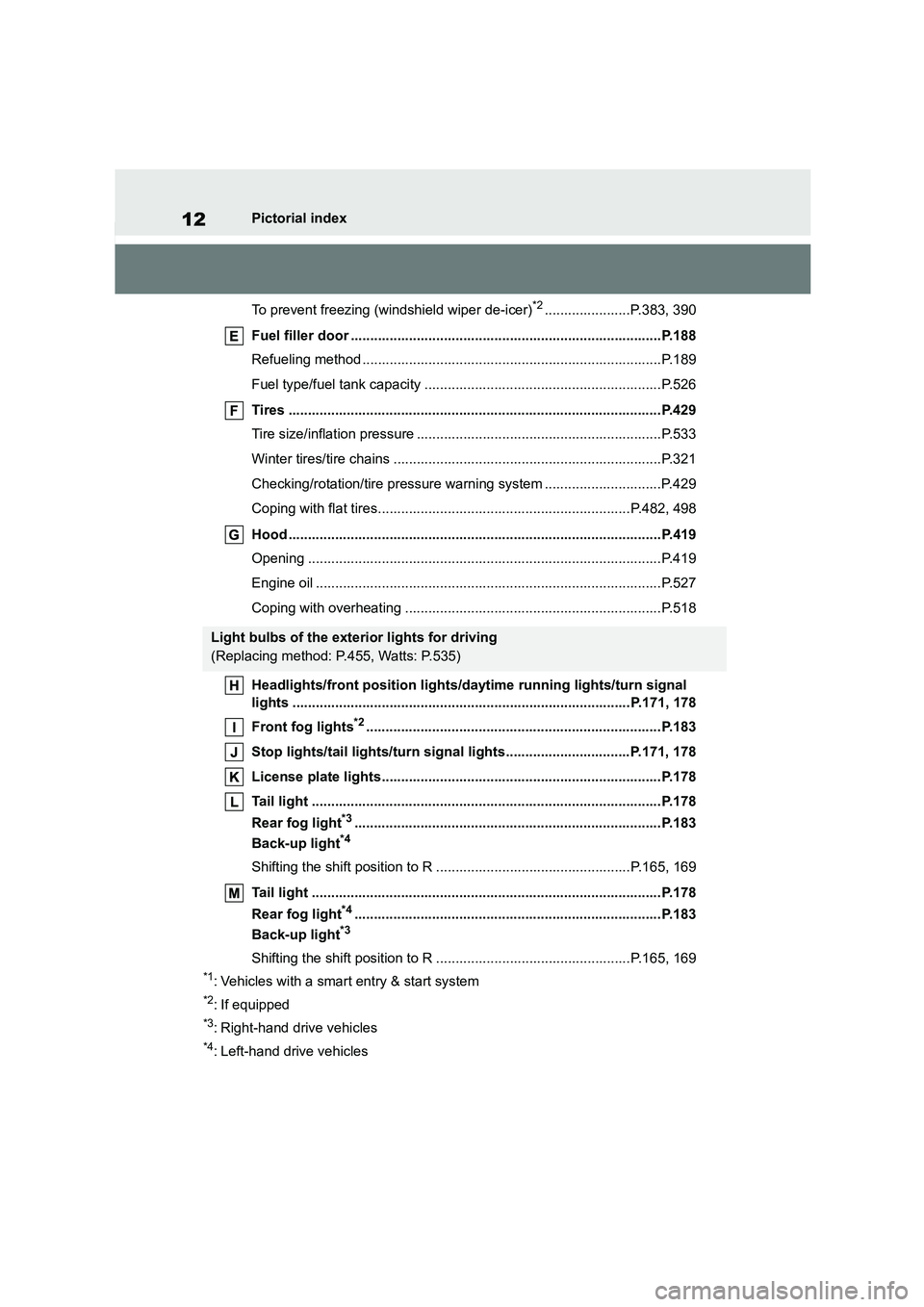
12Pictorial index
To prevent freezing (windshield wiper de-icer)*2......................P.383, 390
Fuel filler door ................................................................................P.188
Refueling method .............................................................................P.189
Fuel type/fuel tank capacity .............................................................P.526
Tires ................................................................................................P.429
Tire size/inflation pressure ...............................................................P.533
Winter tires/tire chains .....................................................................P.321
Checking/rotation/tire pressure warn ing system ..............................P.429
Coping with flat tires.................................................................P.482, 498
Hood ................................................................................................P.419
Opening ...........................................................................................P.419
Engine oil .........................................................................................P.527
Coping with overheating ..................................................................P.518
Headlights/front position lights/daytime running lights/turn signal
lights .......................................................................................P.171, 178
Front fog lights*2............................................................................P.183
Stop lights/tail lights/turn signal lights................................P.171, 178
License plate lights........................................................................P.178
Tail light ..........................................................................................P.178
Rear fog light*3...............................................................................P.183
Back-up light*4
Shifting the shift position to R ..................................................P.165, 169
Tail light ..........................................................................................P.178
Rear fog light*4...............................................................................P.183
Back-up light*3
Shifting the shift position to R ..................................................P.165, 169
*1: Vehicles with a smart entry & start system
*2: If equipped
*3: Right-hand drive vehicles
*4: Left-hand drive vehicles
Light bulbs of the exterior lights for driving
(Replacing method: P.455, Watts: P.535)
Page 145 of 678
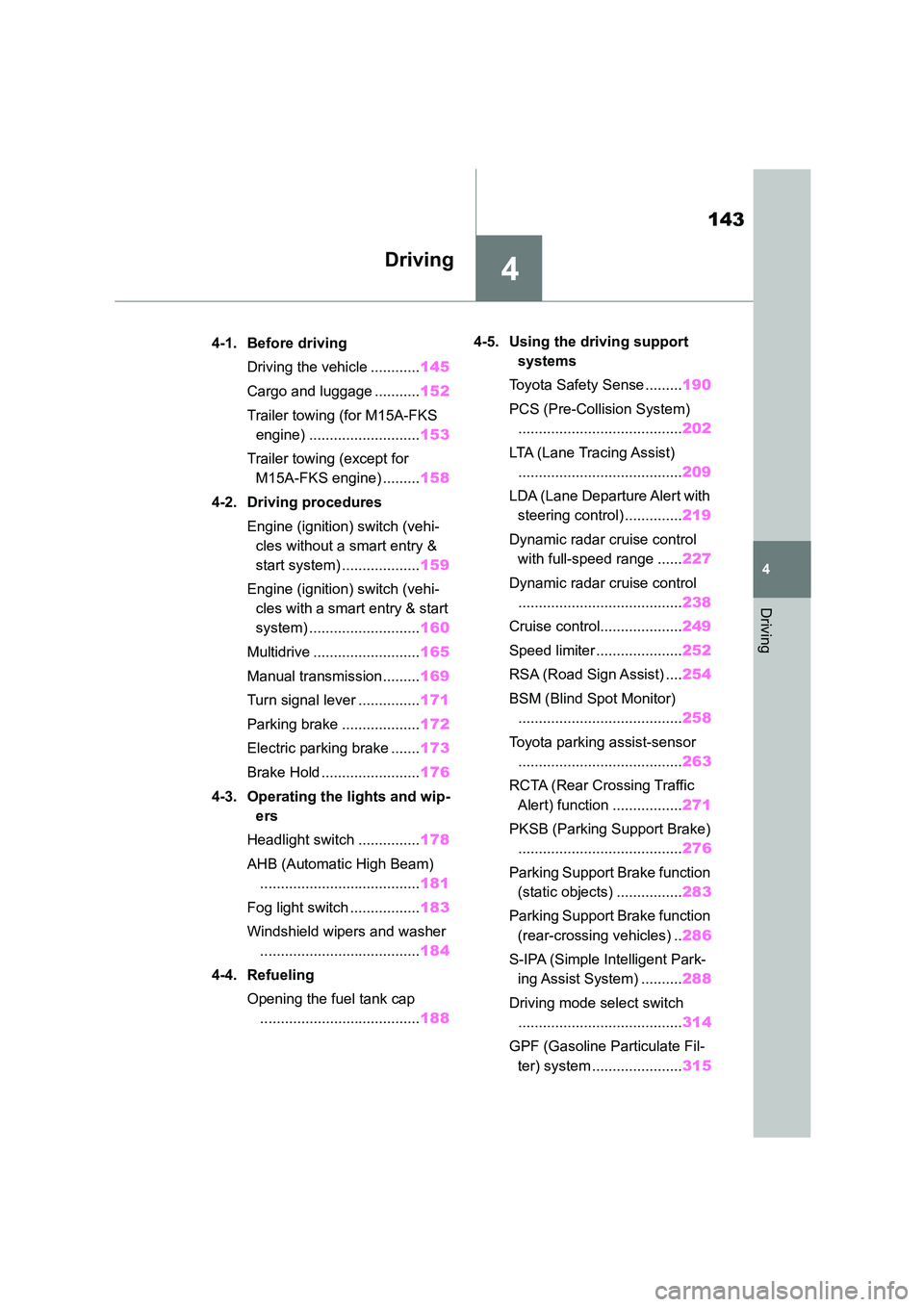
4
143
4
Driving
Driving
.4-1. Before driving
Driving the vehicle ............ 145
Cargo and luggage ........... 152
Trailer towing (for M15A-FKS
engine) ........................... 153
Trailer towing (except for
M15A-FKS engine) ......... 158
4-2. Driving procedures
Engine (ignition) switch (vehi-
cles without a smart entry &
start system) ................... 159
Engine (ignition) switch (vehi-
cles with a smart entry & start
system) ........................... 160
Multidrive .......................... 165
Manual transmission ......... 169
Turn signal lever ............... 171
Parking brake ................... 172
Electric parking brake ....... 173
Brake Hold ........................ 176
4-3. Operating the lights and wip-
ers
Headlight switch ............... 178
AHB (Automatic High Beam)
....................................... 181
Fog light switch ................. 183
Windshield wipers and washer
....................................... 184
4-4. Refueling
Opening the fuel tank cap
....................................... 188
4-5. Using the driving support
systems
Toyota Safety Sense ......... 190
PCS (Pre-Collision System)
........................................ 202
LTA (Lane Tracing Assist)
........................................ 209
LDA (Lane Departure Alert with
steering control) .............. 219
Dynamic radar cruise control
with full-speed range ...... 227
Dynamic radar cruise control
........................................ 238
Cruise control.................... 249
Speed limiter ..................... 252
RSA (Road Sign Assist) .... 254
BSM (Blind Spot Monitor)
........................................ 258
Toyota parking assist-sensor
........................................ 263
RCTA (Rear Crossing Traffic
Alert) function ................. 271
PKSB (Parking Support Brake)
........................................ 276
Parking Support Brake function
(static objects) ................ 283
Parking Support Brake function
(rear-crossing vehicles) .. 286
S-IPA (Simple Intelligent Park-
ing Assist System) .......... 288
Driving mode select switch
........................................ 314
GPF (Gasoline Particulate Fil-
ter) system ...................... 315
Page 149 of 678

147
4
4-1. Before driving
Driving
is performed, the engine output may
be restrained. • When the shift lever is shifted from R
to D, D to R, N to R, P to D, or P to R
(D includes M) with the accelerator pedal depressed, a warning message
appears on the multi-information dis-
play. If a warning message is shown on the multi-information display, read
the message and follow the instruc-
tion. • When the accelerator pedal is
depressed too much while the vehicle
is in reverse.
●While Drive-Start Control is being acti-
vated, your vehicle may have trouble escaping from the mud or fresh snow.
In such case, deactivate TRC
( P.317) to cancel Drive-Start Control so that the vehicle may become able
to escape from the mud or fresh snow.
■Breaking in your new Toyota
To extend the life of the vehicle, observ- ing the following precautions is recom-
mended:
●For the first 300 km (186 miles):
Avoid sudden stops.
●For the first 800 km (500 miles):
Do not tow a trailer.
●For the first 1000 km (621 miles):
• Do not drive at extremely high speeds.
• Avoid sudden acceleration.
• Do not drive continuously in low gears.
• Do not drive at a constant speed for
extended periods.
■Operating your vehicle in a foreign country
Comply with the relevant vehicle regis-
tration laws and confirm the availability
of the correct fuel. ( P.526)
WA R N I N G
Observe the following precautions.
Failure to do so may result in death or
serious injury.
■When starting the vehicle (vehi- cles with a Multidrive)
Always keep your foot on the brake
pedal while stopped with the engine running. This prevents the vehicle
from creeping.
■When driving the vehicle
●Do not drive if you are unfamiliar
with the location of the brake and accelerator pedals to avoid
depressing the wrong pedal.
• Accidentally depressing the accel- erator pedal instead of the brake
pedal will result in sudden accelera-
tion that may lead to an accident.
• When backing up, you may twist
your body around, leading to a diffi- culty in operating the pedals. Make
sure to operate the pedals properly.
• Make sure to keep a correct driving
posture even when moving the
vehicle only slightly. This allows you to depress the brake and accelera-
tor pedals properly.
• Depress the brake pedal using your
right foot. Depressing the brake
pedal using your left foot may delay response in an emergency, result-
ing in an accident.
●Do not drive the vehicle over or
stop the vehicle near flammable
materials. The exhaust system and exhaust
gases can be extremely hot. These
hot parts may cause a fire if there is any flammable material nearby.
Page 155 of 678
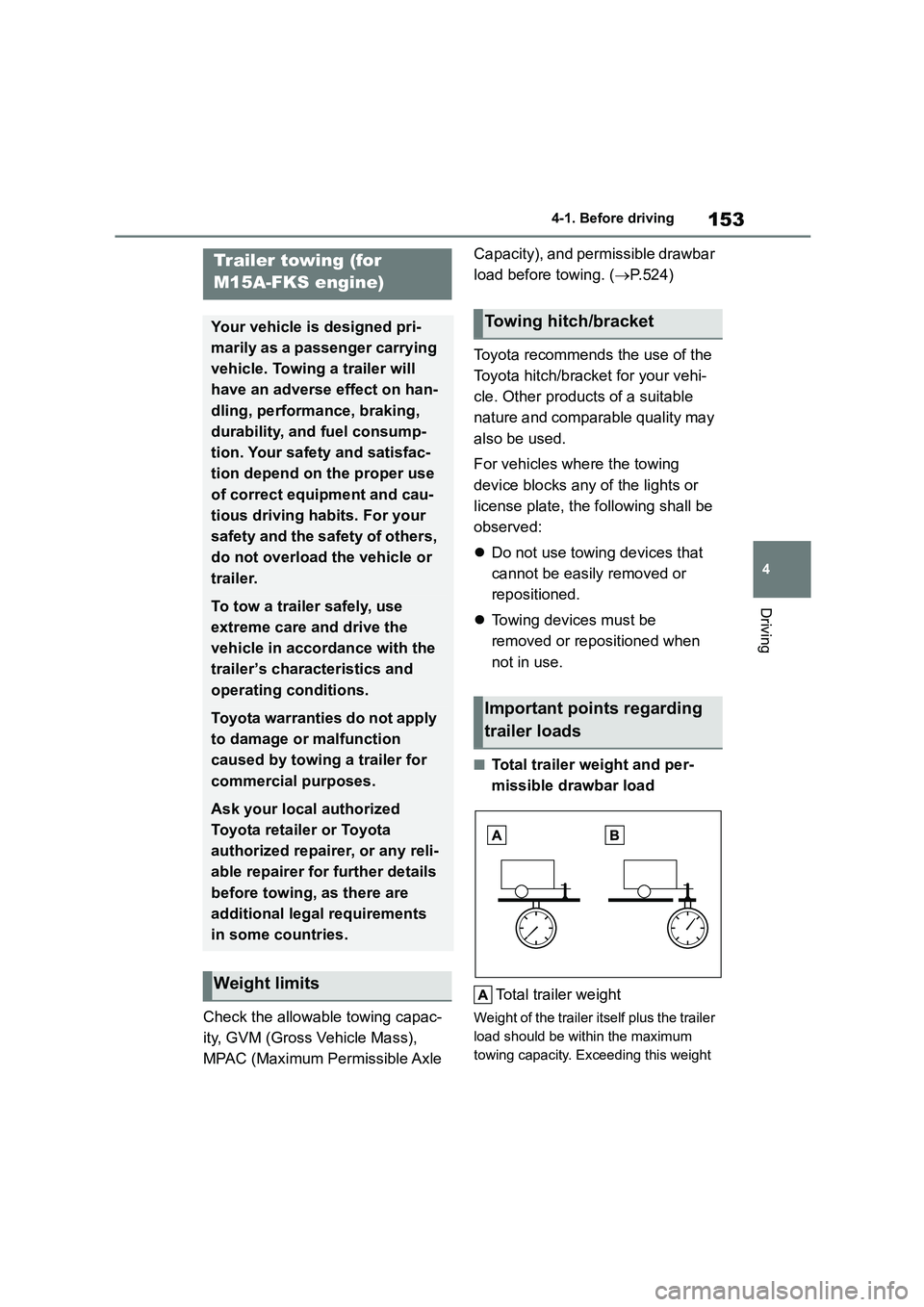
153
4
4-1. Before driving
Driving
Check the allowable towing capac-
ity, GVM (Gross Vehicle Mass),
MPAC (Maximum Permissible Axle
Capacity), and permissible drawbar
load before towing. ( P.524)
Toyota recommends the use of the
Toyota hitch/bracket for your vehi-
cle. Other products of a suitable
nature and comparable quality may
also be used.
For vehicles where the towing
device blocks any of the lights or
license plate, the following shall be
observed:
Do not use towing devices that
cannot be easily removed or
repositioned.
Towing devices must be
removed or repositioned when
not in use.
■Total trailer weight and per-
missible drawbar load
Total trailer weight
Weight of the trailer itself plus the trailer
load should be within the maximum
towing capacity. Exceeding this weight
Trailer towing (for
M15A-FKS engine)
Your vehicle is designed pri-
marily as a passenger carrying
vehicle. Towing a trailer will
have an adverse effect on han-
dling, performance, braking,
durability, and fuel consump-
tion. Your safety and satisfac-
tion depend on the proper use
of correct equipment and cau-
tious driving habits. For your
safety and the safety of others,
do not overload the vehicle or
trailer.
To tow a trailer safely, use
extreme care and drive the
vehicle in accordance with the
trailer’s characteristics and
operating conditions.
Toyota warranties do not apply
to damage or malfunction
caused by towing a trailer for
commercial purposes.
Ask your local authorized
Toyota retailer or Toyota
authorized repairer, or any reli-
able repairer for further details
before towing, as there are
additional legal requirements
in some countries.
Weight limits
Towing hitch/bracket
Important points regarding
trailer loads
Page 190 of 678
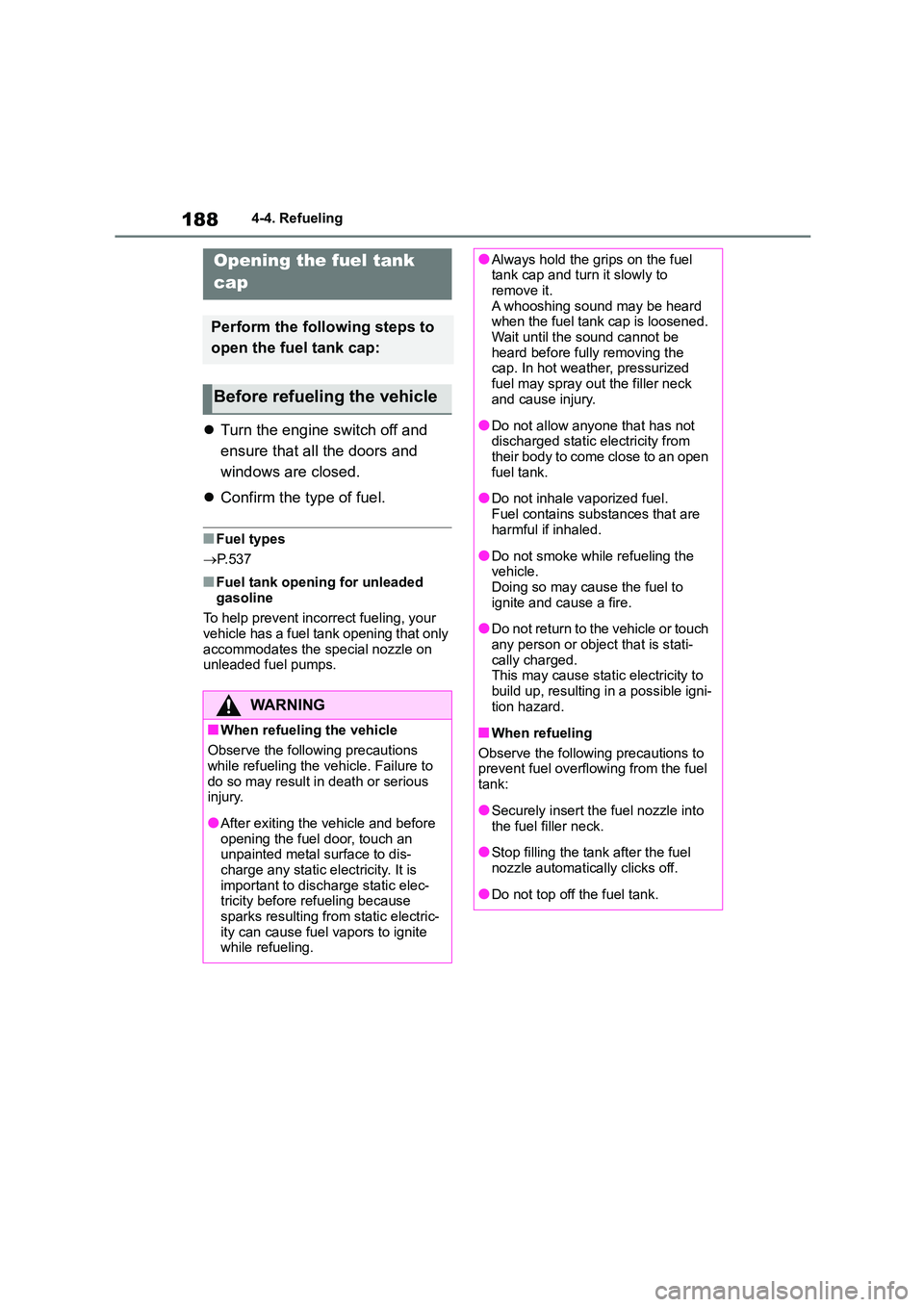
1884-4. Refueling
4-4.Refueling
Turn the engine switch off and
ensure that all the doors and
windows are closed.
Confirm the type of fuel.
■Fuel types
P.537
■Fuel tank opening for unleaded
gasoline
To help prevent incorrect fueling, your vehicle has a fuel tank opening that only
accommodates the special nozzle on
unleaded fuel pumps.
Opening the fuel tank
cap
Perform the following steps to
open the fuel tank cap:
Before refueling the vehicle
WA R N I N G
■When refueling the vehicle
Observe the following precautions
while refueling the vehicle. Failure to
do so may result in death or serious injury.
●After exiting the vehicle and before opening the fuel door, touch an
unpainted metal surface to dis-
charge any static electricity. It is important to discharge static elec-
tricity before refueling because
sparks resulting from static electric- ity can cause fuel vapors to ignite
while refueling.
●Always hold the grips on the fuel tank cap and turn it slowly to
remove it.
A whooshing sound may be heard when the fuel tank cap is loosened.
Wait until the sound cannot be
heard before fully removing the cap. In hot weather, pressurized
fuel may spray out the filler neck
and cause injury.
●Do not allow anyone that has not
discharged static electricity from their body to come close to an open
fuel tank.
●Do not inhale vaporized fuel.
Fuel contains substances that are
harmful if inhaled.
●Do not smoke while refueling the
vehicle. Doing so may cause the fuel to
ignite and cause a fire.
●Do not return to the vehicle or touch
any person or object that is stati-
cally charged. This may cause static electricity to
build up, resulting in a possible igni-
tion hazard.
■When refueling
Observe the following precautions to prevent fuel overflowing from the fuel
tank:
●Securely insert the fuel nozzle into
the fuel filler neck.
●Stop filling the tank after the fuel
nozzle automatically clicks off.
●Do not top off the fuel tank.
Page 191 of 678

189
4
4-4. Refueling
Driving
1 Pull up the opener to open the
fuel filler door.
2 Turn the fuel tank cap slowly
and remove it, then hang it on
the back of the fuel filler door.
After refueling, turn the fuel tank
cap until you hear a click. Once the
cap is released, it w ill turn slightly in
the opposite direction.
NOTICE
■Refueling
Do not spill fuel during refueling.
Doing so may damage the vehicle, such as causing the emission control
system to operate abnormally or dam-
aging fuel system components or the vehicle’s painted surface.
Opening the fuel tank cap
Closing the fuel tank cap
WA R N I N G
■When replacing the fuel tank cap
Do not use anything but a genuine
Toyota fuel tank cap designed for your vehicle. Doing so ma y cause a fire or
other incident which may result in
death or serious injury.
Page 526 of 678
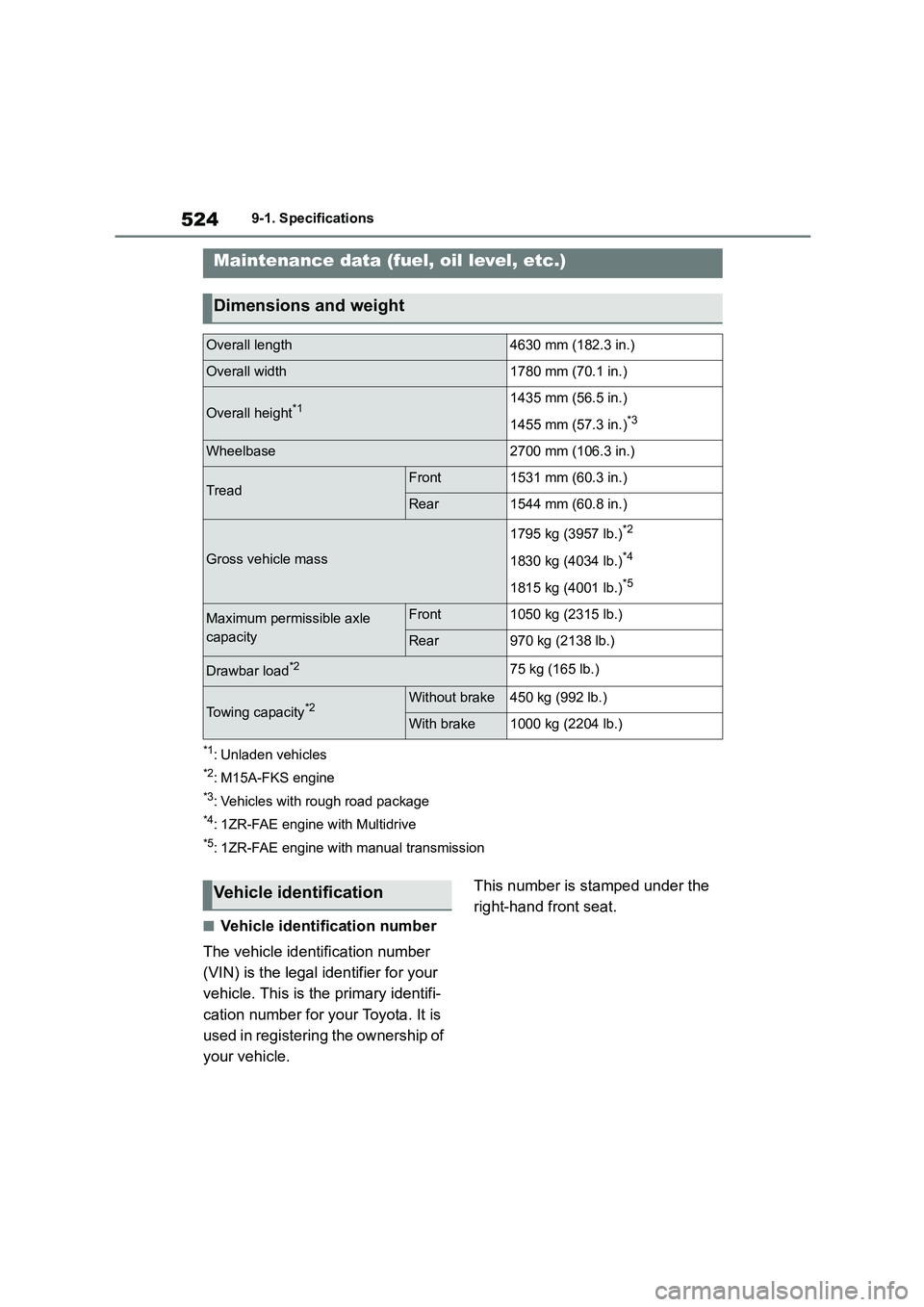
5249-1. Specifications
9-1.Specifications
*1: Unladen vehicles
*2: M15A-FKS engine
*3: Vehicles with rough road package
*4: 1ZR-FAE engine with Multidrive
*5: 1ZR-FAE engine with manual transmission
■Vehicle identification number
The vehicle identification number
(VIN) is the legal identifier for your
vehicle. This is the primary identifi-
cation number for your Toyota. It is
used in registering the ownership of
your vehicle.
This number is stamped under the
right-hand front seat.
Maintenance data (fuel, oil level, etc.)
Dimensions and weight
Overall length4630 mm (182.3 in.)
Overall width1780 mm (70.1 in.)
Overall height*11435 mm (56.5 in.)
1455 mm (57.3 in.)*3
Wheelbase2700 mm (106.3 in.)
TreadFront1531 mm (60.3 in.)
Rear1544 mm (60.8 in.)
Gross vehicle mass
1795 kg (3957 lb.)*2
1830 kg (4034 lb.)*4
1815 kg (4001 lb.)*5
Maximum permissible axle
capacity
Front1050 kg (2315 lb.)
Rear970 kg (2138 lb.)
Drawbar load*275 kg (165 lb.)
Towing capacity*2Without brake450 kg (992 lb.)
With brake1000 kg (2204 lb.)
Vehicle identification
Page 529 of 678
![TOYOTA COROLLA 2022 Owners Manual (in English) 527
9
9-1. Specifications
Vehicle specifications
■Oil capacity (Drain and refill
[Reference*])
1ZR-FAE engine
M15A-FKS engine
*: The engine oil capacity is a reference
quantity to be used TOYOTA COROLLA 2022 Owners Manual (in English) 527
9
9-1. Specifications
Vehicle specifications
■Oil capacity (Drain and refill
[Reference*])
1ZR-FAE engine
M15A-FKS engine
*: The engine oil capacity is a reference
quantity to be used](/img/14/48490/w960_48490-528.png)
527
9
9-1. Specifications
Vehicle specifications
■Oil capacity (Drain and refill
[Reference*])
1ZR-FAE engine
M15A-FKS engine
*: The engine oil capacity is a reference
quantity to be used when changing
the engine oil. Warm up and turn off
the engine, wait more than 5 minutes,
and check the oil level on the dip-
stick.
■Engine oil selection (1ZR-FAE
engine)
“Toyota Genuine Motor Oil” is used
in your Toyota vehicle. Toyota rec-
ommends the use of approved
“Toyota Genuine Motor Oil”.
Another motor oil of matching qual-
ity can also be used.
Oil grade:
0W-20 and 5W-30:
API grade SM “Energy-Conserv-
ing”, SN “Resource-Conserving”,
SN PLUS “Resource-Conserving”
or SP “Resource-Conserving”; or
ILSAC GF-6A multigrade engine oil
Recommended viscosity (SAE):
Preferred
Temperature range anticipated
before next oil change
SAE 0W-20 is filled in to your Toyota
vehicle at manufacturing, and the
best choice for good fuel economy
and good starting in cold weather. If
SAE 0W-20 oil is not available,
SAE 5W-30 oil may be used. How-
ever, it should be replaced with
SAE 0W-20 at the ne xt oil change.
Oil viscosity (0W-20 is explained
here as an example):
• The 0W in 0W-20 indicates the
characteristic of the oil which
allows cold startability. Oils with a
lower value before the W allow
for easier starting of the engine
in cold weather.
• The 20 in 0W-20 indicates the
viscosity characteristic of the oil
when the oil is at high tempera-
ture. An oil with a higher viscos-
Research Octane Number95 or higher
Fuel tank capacity
(Reference)50.0 L (13.2 gal., 11.0 Imp. gal.)
Lubrication system
With filter4.2 L (4.4 qt., 3.7 Imp. qt.)
Without fil-
ter3.9 L (4.1 qt., 3.4 Imp. qt.)
With filter3.4 L (3.6 qt., 3.0 Imp. qt.)
Without fil-
ter3.2 L (3.4 qt., 2.8 Imp. qt.)
Page 530 of 678
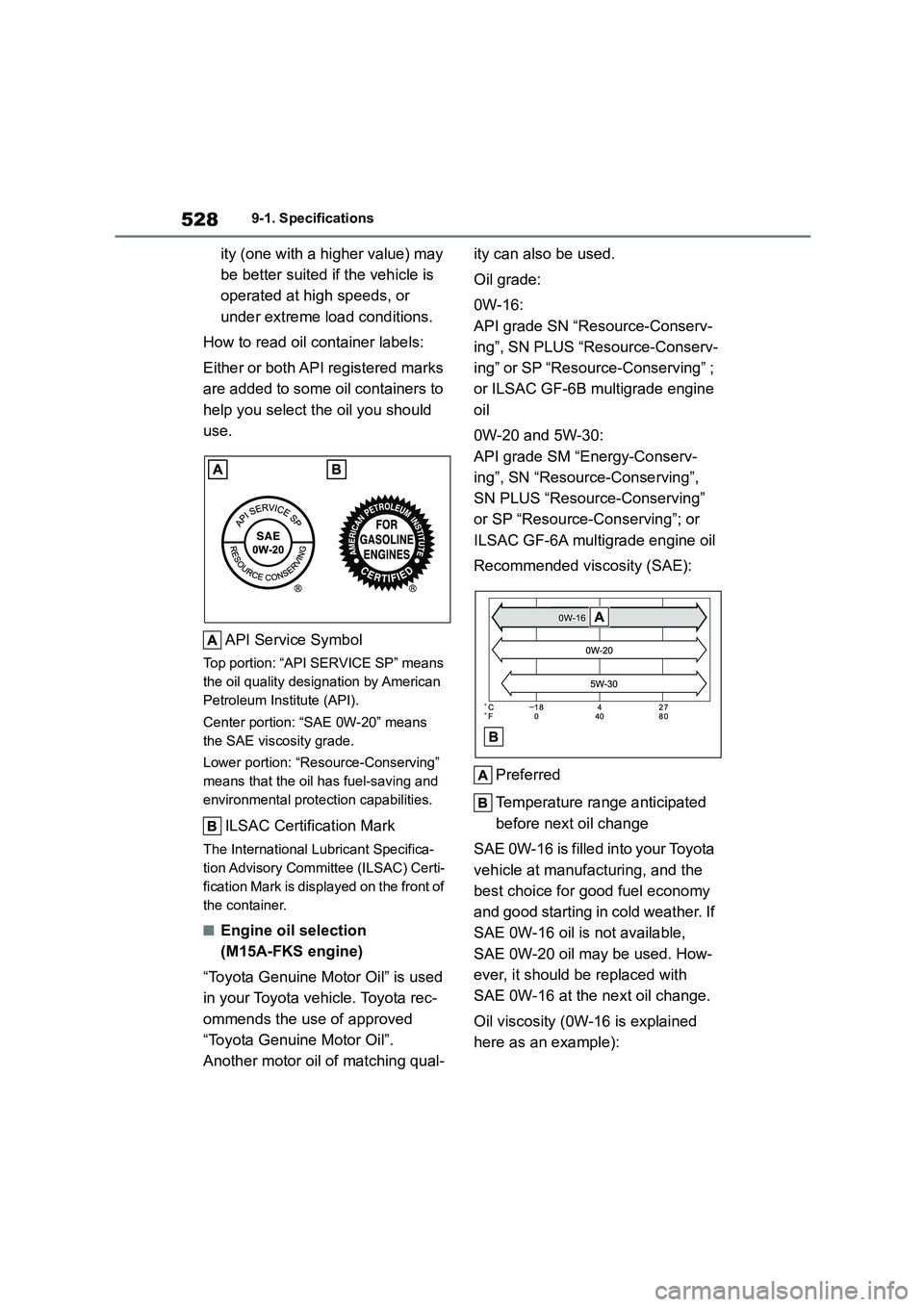
5289-1. Specifications
ity (one with a higher value) may
be better suited if the vehicle is
operated at high speeds, or
under extreme load conditions.
How to read oil container labels:
Either or both API registered marks
are added to some oil containers to
help you select the oil you should
use.
API Service Symbol
Top portion: “API SERVICE SP” means
the oil quality designation by American
Petroleum Institute (API).
Center portion: “SAE 0W-20” means
the SAE viscosity grade.
Lower portion: “Resource-Conserving”
means that the oil has fuel-saving and
environmental protection capabilities.
ILSAC Certification Mark
The International Lubricant Specifica-
tion Advisory Comm ittee (ILSAC) Certi-
fication Mark is displayed on the front of
the container.
■Engine oil selection
(M15A-FKS engine)
“Toyota Genuine Motor Oil” is used
in your Toyota vehicle. Toyota rec-
ommends the use of approved
“Toyota Genuine Motor Oil”.
Another motor oil of matching qual-
ity can also be used.
Oil grade:
0W-16:
API grade SN “Resource-Conserv-
ing”, SN PLUS “Resource-Conserv-
ing” or SP “Resource-Conserving” ;
or ILSAC GF-6B multigrade engine
oil
0W-20 and 5W-30:
API grade SM “Energy-Conserv-
ing”, SN “Resource-Conserving”,
SN PLUS “Resource-Conserving”
or SP “Resource-Conserving”; or
ILSAC GF-6A multigrade engine oil
Recommended viscosity (SAE):
Preferred
Temperature range anticipated
before next oil change
SAE 0W-16 is filled in to your Toyota
vehicle at manufacturing, and the
best choice for good fuel economy
and good starting in cold weather. If
SAE 0W-16 oil is not available,
SAE 0W-20 oil may be used. How-
ever, it should be replaced with
SAE 0W-16 at the ne xt oil change.
Oil viscosity (0W-16 is explained
here as an example):